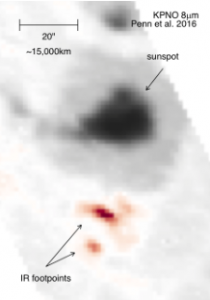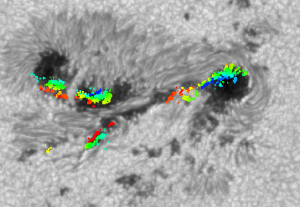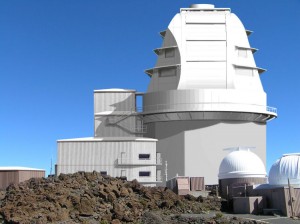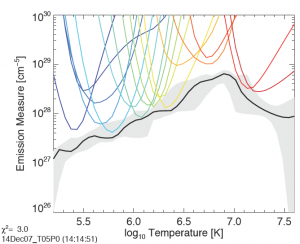Research led by Dr. Paulo Simoes has been featured as a research highlight in a press release from the 15th European Solar Physics meeting, held recently in Hungary. Paulo’s work uses numerical simulations to predict the behaviour of chromospheric flare emission in the infrared continuum, and understand how it can be used to track the evolution of chromospheric ionisation. Armed with this new knowledge, new observations with the Daniel K. Inouye Solar Telescope will be proposed.
Author Archives: Lyndsay Fletcher
Group members take on new IAU roles
Congratulations to Eduard Kontar and Nic Labrosse who have been newly elected to positions in the International Astronomical Union. Eduard has been elected to the Steering Committee of Division E (Sun and Heliosphere) and Nic to the Steering Committee of Commission E1 (Solar Radiation and Structure). Lyndsay Fletcher also takes over the Presidency of Commission E2 (Solar Activity) and remains as an ex officio member of Division E. All three group members formally assume their new roles after the closing ceremony of the XXIXth General Assembly of the IAU in Honolulu on 14th August 2015.
Congratulations to Graham Kerr
Graham Kerr, a PhD student in the Astronomy and Astrophysics Group, has won the School of Physics and Astronomy’s Thomson Prize for his second year report on Observations and Modelling of Solar Chromospheric Flares. Well done Graham!
Glasgow astronomers join UK DKIST consortium
The School of Physics and Astronomy has joined the UK Consortium for the Daniel K. Inouye Solar Telescope currently being constructed on the summit of Haleakala mountain in Hawai’i. This 4m diameter telescope will address fundamental questions at the core of contemporary solar physics. It will do this via high-speed (sub-second) imaging, spectroscopic and magnetic measurements of the solar photosphere, chromosphere and corona. DKIST will be mainly funded by the US National Science Foundation. The UK DKIST Consortium, funded also by the STFC and in kind by Andor Technology, exists to design and build the cameras for 4 DKIST instruments, develop processing and data analysis tools, and support UK observing proposals.
PhD student paper wins Scottish prize
Congratulations to David Graham, whose paper “The Emission Measure Distribution of Impulsive Phase Flare Footpoints“, published while he was a PhD student in the A&A group, has won this year’s Robert Cormack Bequest Postgraduate Prize. This prize, awarded annually by the Royal Society of Edinburgh, is for the best nominated paper accepted for publication in 2013/14 with a postgraduate in a Scottish Institution as prime author. David gets a cheque for a helpful sum, and an invitation to speak to the annual Cormack Astronomy Meeting in November.
The paper investigates the temperature distribution of the plasma produced in the lower atmosphere (footpoints) of a flare during the phase of primary energy injection, finding a distribution peaking at 10MK and with a slope consistent with thermal conduction. It is the first time that the properties of flare footpoints have been investigated in this way. Co-authors were Iain G. Hannah, Lyndsay Fletcher (both GU) and Ryan O. Milligan (Queen’s University Belfast)
Well done David!
Graham Kerr wins Hunter-Cumming Prize
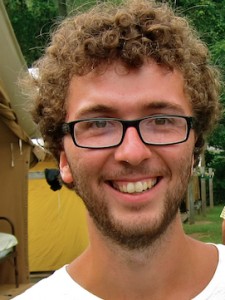 Graham Kerr, a second year Astronomy and Astrophysics PhD student has won the Hunter-Cumming Prize for his first year work, presented in his report on ‘Observations and Modelling of Solar Chromospheric Flares’. Graham has been working on observations of solar flares in the optical part of the spectrum, using data from the Hinode spacecraft to deduce the temperature and energy content of ‘white light’ flares. He has recently begun running radiation hydrodynamic simulations, to help interpret the behaviour that is observed. Congratulations Graham!
Graham Kerr, a second year Astronomy and Astrophysics PhD student has won the Hunter-Cumming Prize for his first year work, presented in his report on ‘Observations and Modelling of Solar Chromospheric Flares’. Graham has been working on observations of solar flares in the optical part of the spectrum, using data from the Hinode spacecraft to deduce the temperature and energy content of ‘white light’ flares. He has recently begun running radiation hydrodynamic simulations, to help interpret the behaviour that is observed. Congratulations Graham!
Dr. Iain Hannah – new Royal Society University Research Fellow
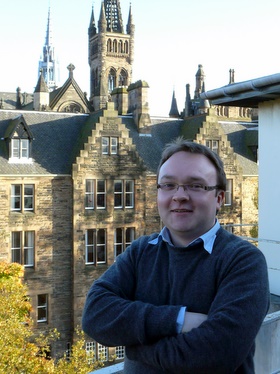 We congratulate Dr Iain Hannah from our group who has taken up his post as one of 41 new Royal Society University Research Fellows (URFs) for 2013, to conduct a research programme into the physics of high energy solar flares. The University Research Fellowship scheme aims to provide outstanding scientists, who have the potential to become leaders in their chosen fields, with the opportunity to build an independent research career. Iain’s research into solar flares involves X-ray imaging and spectroscopy, multi-wavelength studies, statistical surveys and numerical simulations.
We congratulate Dr Iain Hannah from our group who has taken up his post as one of 41 new Royal Society University Research Fellows (URFs) for 2013, to conduct a research programme into the physics of high energy solar flares. The University Research Fellowship scheme aims to provide outstanding scientists, who have the potential to become leaders in their chosen fields, with the opportunity to build an independent research career. Iain’s research into solar flares involves X-ray imaging and spectroscopy, multi-wavelength studies, statistical surveys and numerical simulations.
